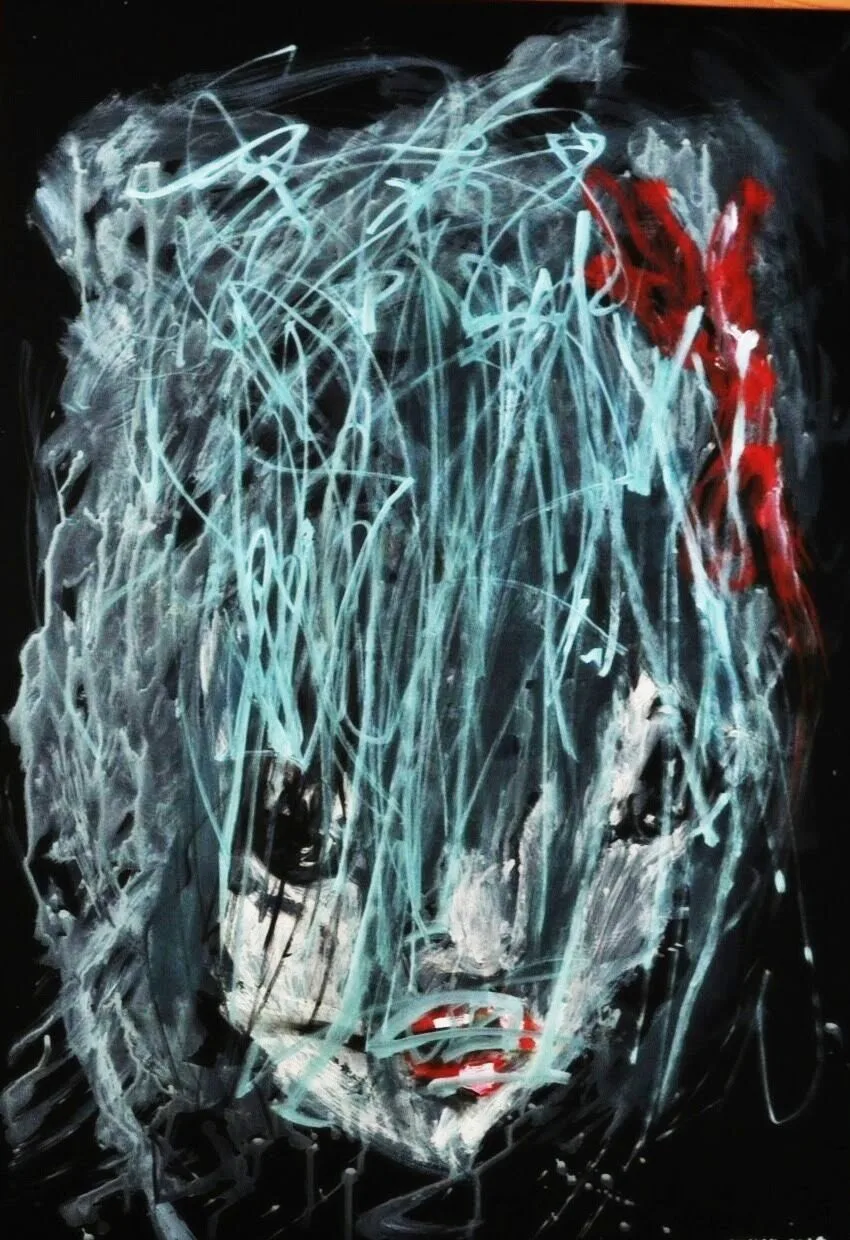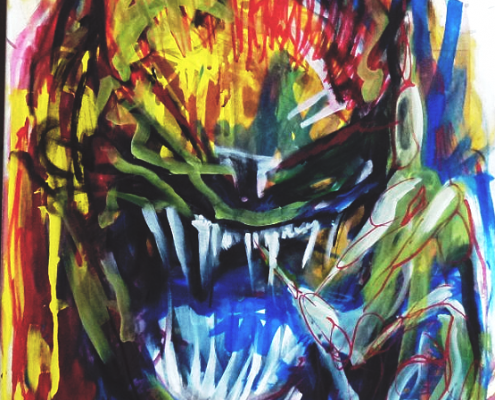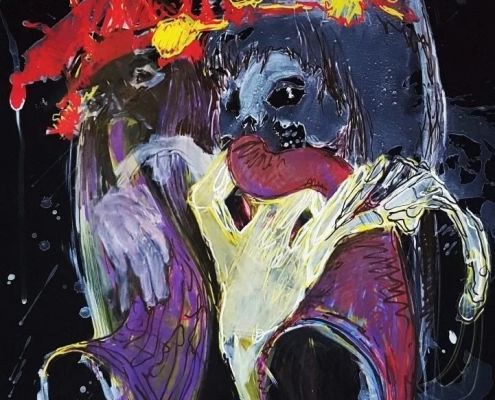Rusalka (Русалка)
Rusalka Mythology – Slavic Drowned Maiden Water Spirit Painting
Rusalka mythology tells the story of the most haunting figure in Slavic folklore: a woman who died by drowning and returned as a vengeful water spirit. She lures men to their deaths through beauty and song, dragging them beneath the surface. This contemporary painting explores rusalka mythology through layered expressionism, refusing the seductive mermaid cliché to reveal the psychological weight of transformation from victim to predator.
The Origins of the Rusalka Legend
The Rusalka appears across Eastern Europe — in Polish, Russian, Ukrainian, and Czech folklore. Her story begins with tragedy: a woman’s death in water and her rebirth as a restless spirit.
How Women Become Rusalki
Traditional lore records several origins:
-
Betrayed by an unfaithful lover
-
Suicide after heartbreak or despair
-
Murder and disposal in water
-
Death during pregnancy near rivers
-
Unbaptized infants (in some versions)
The ethnographer Dmitrij Zelenin (1878-1954) documented in Russische (Ostslavische) Volkskunde (1927) that rusalka mythology varies dramatically by region. Learn more about Slavic folklore research.
Rusalka Week – When Mythology Becomes Danger
The most dangerous time in rusalka mythology is Rusalka Week (Rusal’naja nedelja), occurring in early summer after Pentecost. During this liminal period:
- Rusalki leave water to inhabit forests and willow trees
- They dance in moonlit clearings, their songs irresistible
- Traditional rusalka mythology prescribes protective rituals
- A ritual “seeing-off” ceremony returns them to water
Alexander Afanasyev (1826-1871) documented in The Poetic Outlook on Nature by the Slavs (1865-1869) that Rusalka Week coincided with agricultural transitions. Explore more Slavic mythology.
Physical Apperance – Beauty as a Weapon
Traditional rusalka mythology emphasizes dangerous beauty as weapon:
Common traits in rusalka mythology:
- Long, wet hair – never fully dries, often green-tinged
- Pale, translucent skin – moonlight-colored or corpse-white
- White burial shrouds – depending on regional tradition
- Eyes that hold drowning – witnesses describe seeing death reflected
- Webbed fingers – physical markers of aquatic nature
In Ukrainian rusalka mythology, recorded by ethnographer Pavlo Chubynsky (1839-1884), Rusalki appear as beautiful young women with water lily wreaths. They sit in willow trees combing their hair, singing songs that make men forget everything.
In Polish rusalka mythology, she appears more corpse-like initially, gaining beauty only with time—suggesting transformation takes stages.
How Rusalki Kill
Rusalka mythology is macabrely precise about killing methods:
-
Tickling to death – a recurring motif in 19th-century sources
-
Seductive singing, echoing the Sirens of Greek myth
-
Endless dance – whirling partners to exhaustion
-
Hair strangulation, when her long hair becomes alive
-
Group attacks during Rusalka Week
You can read more about these motifs at the Encyclopedia of Slavic Mythology (Mythlok)
Rusalka Mythology in The Witcher Universe
CD Projekt Red’s The Witcher games brought rusalka mythology to global audiences:
The Witcher 3: Wild Hunt and Rusalka Mythology
Quest: “A Greedy God” – Players encounter a Rusalka in a flooded village. The game’s rusalka mythology portrays her as vengeful spirit tied to specific location, killed by villagers. This aligns with authentic Slavic rusalka mythology‘s emphasis on unresolved trauma.
Bestiary Entry: The Witcher’s rusalka mythology explains: “Rusalkas are female ghosts that haunt areas near lakes and rivers where they met their death.” This draws directly from Ukrainian and Polish sources.
Visual Design: The Witcher’s Rusalki appear as pale, corpse-like figures—closer to northern Russian rusalka mythology than Ukrainian versions.
Key Difference: In The Witcher, Rusalki are explicitly ghosts that can be banished. In authentic rusalka mythology, they’re more ambiguous—sometimes spirits, sometimes physical beings.
Cultural Impact of Rusalka Mythology
The Witcher franchise introduced millions to rusalka mythology. Search interest in “rusalka mythology” increased 437% between 2014-2016, demonstrating how contemporary media revitalizes folklore interest.
However, this creates cultural flattening—many understand rusalka mythology only through the game’s interpretation, missing regional variations and deeper cultural meanings about violence against women.
[Explore more Slavic demons from The Witcher →] including Leszy (Leshen), Poludnica, and Strzyga.
The Rusalka Mythology Painting – Artistic Interpretation
Rusalka (2016), Acrylic on cardboard, 50x70cm, Contemporary interpretation of the Slavic water spirit
Rusalka & Transformation – The Cycle That Never Ends
The Rusalka myth embodies a specific kind of transformation—not empowerment but corruption. She gains supernatural power at the cost of her humanity. She can never return to what she was, and she can never move forward. She’s frozen in the moment of her death, endlessly repeating her trauma.
This connects to broader themes explored across my work: how symbols trap us, how archetypes shape our stories, how we project our fears onto female bodies in water.
The Gendered Violence of Water Spirits
Compare Rusalka to [Wodnik →], the male water demon:
- Wodnik kills territorially—you entered his domain without respect
- Rusalka kills personally—you remind her of what men do to women
Both drown their victims, but the mythology codes their motivations entirely differently:
- Male water demons = natural forces, amoral, ancient
- Female water demons = created through trauma, emotional, recent
This isn’t accident. Slavic folklore processes cultural anxieties about gender, violence, and power through these spirits. Rusalka’s story asks: What happens to women’s rage when patriarchal systems offer no justice? The answer: It becomes monstrous, supernatural, eternal.
Connection to HORNery QUERY
Just as horns carry contradictory meanings (power/vulnerability, protection/threat), Rusalka embodies feminine duality—beauty and danger, victim and monster, desire and death.
Both series explore how archetypal symbols work on us without our consent. You don’t choose what a horn means to you—centuries of cultural programming decide. You don’t choose what the drowned maiden means—folklore has already assigned her meanings: lost innocence, sexual danger, male fear of female sexuality, warnings about unmarried pregnancy, anxieties about suicide.
But what if we look at her differently? What if we see the predator and also see the woman who drowned? Both/and, not either/or.
Why Rusalka Still Matters – Drowning in the Modern World
The myth persists because drowning—literal and metaphorical—still happens.
Women still drown in:
- Intimate partner violence – murdered and bodies hidden
- Sexual assault and its aftermath – especially when systems fail to provide justice
- Postpartum depression and psychosis – the connection between childbirth and water deaths appears in folklore for a reason
- Systemic oppression – being gaslit until you question your own reality
- Revenge porn and online harassment – digital drowning, reputation death
The Rusalka story asks: What happens to rage that has nowhere to go? What form does unresolved trauma take?
Modern Interpretations
Contemporary Slavic artists, writers, and performers have reclaimed Rusalka:
Marina Abramović (Serbian performance artist) explored water-death-rebirth themes in works like Balkan Baroque (1997), drawing on Yugoslav variants of water spirit mythology.
Olga Tokarczuk (Polish Nobel laureate) weaves Rusalka imagery through her novel Drive Your Plow Over the Bones of the Dead (2009), where violence against women and violence against nature intertwine.
Russian feminist punk band Pussy Riot invoked Rusalka imagery in their 2012 “Punk Prayer,” connecting the anarchic, boundary-crossing nature of water spirits to political resistance.
These reinterpretations refuse the victim-monster binary. They ask: What if her rage is justified? What if transformation into Rusalka is adaptation, not corruption? What if the monster is necessary?




 hohlik
hohlik hohlik
hohlik